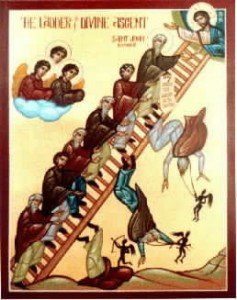 The very last step on John’s LADDER is FAITH, HOPE AND LOVE. John writes, And now at last, after all that has been said, there remains that triad, faith, hope and love, binding and securing the union of all. “But the greatest of these is love”, since that is the very name of God Himself. To me they appear, one as a ray, one as light and one as a disk,” and all as a single radiance and a single splendor.
The very last step on John’s LADDER is FAITH, HOPE AND LOVE. John writes, And now at last, after all that has been said, there remains that triad, faith, hope and love, binding and securing the union of all. “But the greatest of these is love”, since that is the very name of God Himself. To me they appear, one as a ray, one as light and one as a disk,” and all as a single radiance and a single splendor.
We have reached the pinnacle of the LADDER, the summit of virtue, which is love. But from the above passage it is clear that just as Christians speak of God as Trinity and never as Father, Son and Holy Spirit in isolation from one another, so too when we speak of love, we cannot do so without including faith and hope. These three virtues – faith, hope, and love – are the “Holy Trinity” of the spiritual life. Without the former virtues, love becomes only a vague sentiment. When we see all three as one virtue, we are able to have a better grasp of what love means.
Paul says in his first letter to Timothy, God “desires all men and women to be saved and to come to the knowledge of the truth”. John says in his Gospel that Jesus is the way, the truth and the life”. So love, as a Christian virtue, or rather the Christian virtue which embraces all virtues, is rooted in the knowledge of God. This is why Eastern Christian mysticism is never separated from dogma and theology. The purpose of both doctrine and mysticism is to know the true God, who is love.
Love, by its nature, is a resemblance to God, insofar as this is humanly possible. In its activity it is inebriation of the soul. Its distinctive character is to be a fountain of faith, an abyss of patience, a sea of humility.
Only the dispassionate can acquire perfect faith, hope and love, but we cannot even make a true beginning of spiritual life if we do not possess these virtues to some degree.
More to follow!
